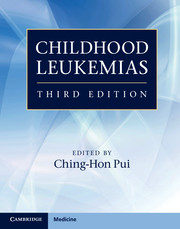Book contents
- Frontmatter
- Contents
- List of contributors
- Preface
- Section 1 History and general issues
- Section 2 Cell biology and pathobiology
- Section 3 Evaluation and treatment
- 12 Pharmacokinetic, pharmacodynamic, and pharmacogenetic considerations
- 13 Acute lymphoblastic leukemia
- 14 Relapsed acute lymphoblastic leukemia
- 15 B-cell acute lymphoblastic leukemia and Burkitt lymphoma
- 16 Acute myeloid leukemia
- 17 Relapsed acute myeloid leukemia
- 18 Myelodysplastic syndrome
- 19 Chronic myeloproliferative disorders
- 20 Leukemias in patients with Down syndrome
- 21 Treatment of adolescents and young adults with acute lymphoblastic leukemia
- 22 Hematopoietic stem cell and natural killer cell transplantation
- 23 Treatment of acute leukemia in countries with limited resources
- 24 Antibody-targeted therapy
- 25 Adoptive cellular immunotherapy
- 26 Gene transfer: methods and applications
- 27 Development therapeutics
- 28 Minimal residual disease
- Section 4 Complications and supportive care
- Index
- Plate Section
- References
12 - Pharmacokinetic, pharmacodynamic, and pharmacogenetic considerations
from Section 3 - Evaluation and treatment
Published online by Cambridge University Press: 05 April 2013
- Frontmatter
- Contents
- List of contributors
- Preface
- Section 1 History and general issues
- Section 2 Cell biology and pathobiology
- Section 3 Evaluation and treatment
- 12 Pharmacokinetic, pharmacodynamic, and pharmacogenetic considerations
- 13 Acute lymphoblastic leukemia
- 14 Relapsed acute lymphoblastic leukemia
- 15 B-cell acute lymphoblastic leukemia and Burkitt lymphoma
- 16 Acute myeloid leukemia
- 17 Relapsed acute myeloid leukemia
- 18 Myelodysplastic syndrome
- 19 Chronic myeloproliferative disorders
- 20 Leukemias in patients with Down syndrome
- 21 Treatment of adolescents and young adults with acute lymphoblastic leukemia
- 22 Hematopoietic stem cell and natural killer cell transplantation
- 23 Treatment of acute leukemia in countries with limited resources
- 24 Antibody-targeted therapy
- 25 Adoptive cellular immunotherapy
- 26 Gene transfer: methods and applications
- 27 Development therapeutics
- 28 Minimal residual disease
- Section 4 Complications and supportive care
- Index
- Plate Section
- References
Summary
Introduction
Pediatric leukemias are among the most drug responsive of human malignancies. Over 80% of children with acute lymphoblastic leukemia (ALL) can now be cured by systemic chemotherapy. Because of their drug responsiveness, childhood leukemias remain an excellent model for evaluating the pharmacodynamics, kinetics, and genetics of anti-cancer drugs.
Pharmacokinetics is the study of the absorption, distribution, metabolism, and excretion of drugs. Pharmacodynamics characterizes the relationship between pharmacokinetics and pharmacologic effects, either adverse or therapeutic. Considerable interindividual variability exists in the pharmacokinetics and in the pharmacodynamics of many anti-leukemic agents in children. Pharmacogenetics/pharmacogenomics is the inherited basis for interindividual differences in pharmacokinetics/pharmacodynamics of medications, and the individualization of therapy based on germline genotypes may be one means of minimizing interindividual variability in response to anti-leukemic agents and optimizing treatment.
Many medications exhibit broad interpatient variability and for those drugs with a wide therapeutic index (e.g., penicillins), these patient-specific differences are unlikely to affect either efficacy or toxicity. For medications with wide therapeutic indices, the vast majority of patients can be given doses high enough to produce the desired therapeutic response with little risk of toxicity. In contrast, anti-leukemic agents have a very narrow therapeutic index with substantial risk for toxicity at doses required for therapeutic effects. Furthermore, the subset of patients with the highest rate of drug clearance (i.e., metabolism, elimination) may experience suboptimal systemic exposure (i.e., blood concentration) at standard doses. Those investigations of concentration–effect relationships that have been established and linked to host genetic polymorphisms are the primary focus of this chapter.
- Type
- Chapter
- Information
- Childhood Leukemias , pp. 309 - 331Publisher: Cambridge University PressPrint publication year: 2012



